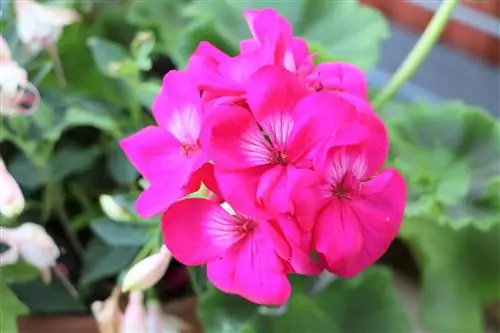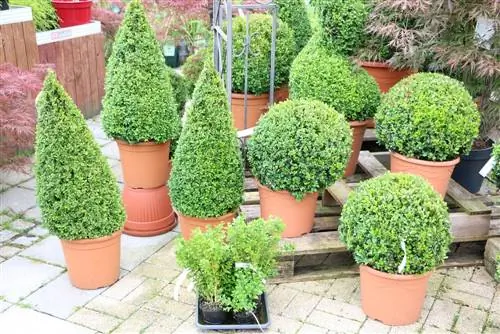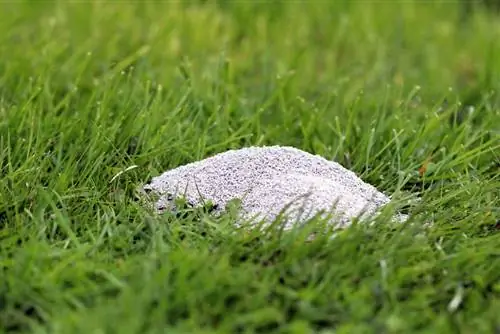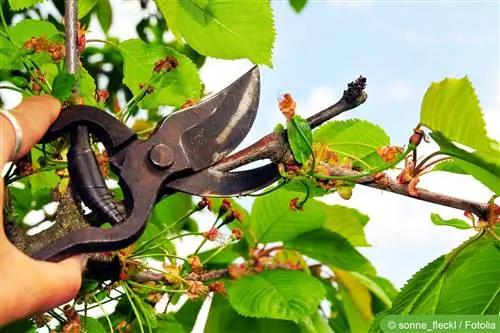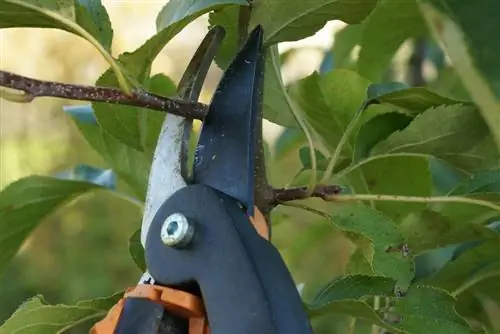- Author admin [email protected].
- Public 2023-12-17 03:39.
- Last modified 2025-06-01 06:48.
Geraniums belong to the family of the so-called cranesbill plants (botanically: Geraniaceae). In contrast to most of its family members, the geranium, which originally comes from southern Africa and whose botanical name is Pelargonium, is not winter hardy, which is why it must be brought into the house to overwinter in the fall, as soon as the days get shorter and the nights get colder. Before doing so, you should cut them back for several reasons.
The first step
Before you start the actual pruning, you should remove the leaves of the geranium. It must be noted that you should not only remove the dried leaves, but also most of the lush green leaves. Some gardeners or florists even go so far as to remove all leaves without exception. The reason for this is, on the one hand, that geraniums need less liquid and nutrients over the winter, the fewer leaves they have. On the other hand, leafy geraniums are more susceptible to diseases. In addition, dense foliage encourages pest infestation. Regardless of this, leafless geraniums hardly take up any space, which is an advantage if you want to overwinter several plants together in a single pot.
The actual pruning
It is generally advised to cut back all geranium shoots without exception by a good two thirds to a total length of a maximum of 10 to 15 cm. However, it should be remembered that the geraniums should be cut again in spring in order to be able to sprout better as soon as they come outdoors again. It is therefore advisable to only trim the geraniums by half or a third in autumn. In general, it is important to ensure that around two to three nodes remain per side shoot. However, there should not be more nodes left, otherwise the geranium would have too many fresh shoots next year. When cutting back, you should use secateurs that are as sharp as possible and should be cleaned thoroughly beforehand. Otherwise there is a risk that any pathogens from previous pruning may still be clinging to the scissors, which could be transferred to your geranium.
Tip:
You can grow new plants from the cut shoots by simply placing them in clear water on the bright windowsill and later repotting them as soon as the so-called cuttings have formed their first roots.
Be careful with supposedly dead shoots
When pruning geraniums, it is important to completely remove all dead shoots. However, you should exercise particular caution here, as the main wooden shoots often look dead without actually being dead. To find out which shoots are really dead, it is usually enough to lightly press them between your index finger and thumb. If the shoots feel unusually soft or even downright rotten, this is a clear indication that they are actually dead.
Tip:
If shoots are only partially dead, it is usually sufficient to shorten them about 1 or 2 cm deep into the he althy wood towards the trunk.
Trimming the roots
Before bringing your geraniums indoors to overwinter, it's best to repot them to ensure their soil is free of bugs and potential pathogens. Apart from that, it may be advisable to trim the roots a little in addition to the shoots, for which you would have to completely remove the soil anyway. When trimming or thinning the roots, you primarily remove fibrous, thin “roots” by either picking them off by hand or cutting them off with pruning shears. However, you should make sure that a sufficiently large proportion of the so-called fine roots remain, as your geraniums absolutely need them to survive. Finally, if necessary, you can cut back the actual trunk or main roots a little, although a certain amount of restraint is required here, otherwise there is a risk that your geraniums will no longer grow properly.
Tip:
Always repot geraniums after cutting back the shoots, as they are then much easier to handle.
Further tips for overwintering geraniums
The most important criterion when overwintering geraniums is the location, which should be as bright as possible. In addition, the ambient temperature should be at least 5 to a maximum of 10 °C. In this context, it must be noted that in moderately lit winter quarters, cooler temperatures should be preferred, otherwise the geraniums could sprout prematurely. It is also important that the geranium soil is kept slightly moist at all times.
The spring cut
As previously noted, you should prune your geraniums again in the spring. How many centimeters you should prune your geraniums depends, of course, on how far you cut them back in the fall. As a result, no binding information can be given to you at this point. In principle, however, all dry areas on the cut edges of the previous pruning should be cut off in autumn without exception. Consequently, when pruning in autumn, you should be as careful as possible to leave a minimum distance of a good centimeter or more between the thickened plant buds and the cut site. Apart from that, it may be advisable to provide the geraniums with fresh soil again after spring pruning to ensure that they are optimally supplied with nutrients during their budding phase. It must be noted that plants reduce their nutrient intake to such an extent during the winter that the fresh soil from the previous repotting in autumn should still be nutrient-rich enough to adequately cover the rapidly increasing nutrient requirements of your geraniums in spring.
Conclusion
First, the geraniums are (almost) completely freed of their foliage. Then all the shoots are trimmed to the desired length using secateurs that are as sharp as possible and have been cleaned in advance, although it is important to maintain a minimum distance between the buds and the interface. The geraniums can then be placed in fresh garden soil, although the roots should be thinned out a little and shortened if necessary.
Frequently asked questions
Do I need to fertilize my geraniums after I cut them back?
No, since the nutrient requirements of your geraniums are generally very low throughout the winter and only increase again next spring with the next growth phase, you do not need to fertilize extra. In fact, it is even advisable to avoid fertilizing completely during the winter.
Where do thin shoots come from?
Why could it be that my geraniums developed weak shoots with pale green leaves over the winter after they were pruned in the fall? - In all likelihood, the location was/is too dark and warm, causing your geraniums to start sprouting again too early.
Do I have to treat the fresh cuts somehow after cutting them back?
No, as a rule the interfaces do not need to be treated as they usually dry out quickly, which provides a kind of natural protection.
Geranium care in spring
- Spring cleaning keeps geraniums he althy and blooming. Remove wilted and damaged leaves.
- Short the green, firm shoots to three to four leaf bases so that they branch out richly, and remove damaged shoots.
- Well-rooted plants get a new pot in spring, which leaves 2 to 3 cm of space around the ball for new soil.
- Use fresh balcony potting soil mixed with some gravel or sand. Leave a 2 cm high pouring rim.
- Once a week you should supply geraniums with liquid fertilizer, which you mix into the irrigation water.
- Alternatively, you can add slow-release fertilizer or fertilizer sticks to the soil at the beginning of the season, which will last for several months.
How to make a stem
Well-formed geranium standard stems are a feast for the eyes. However, they are not cheap if you buy them from a gardener. But there are alternatives. You can grow tall stems yourself:
- Select a he althy, strong geranium and cut off all but one main shoot at the base.
- So that the tree grows straight, the shoot is tied to a support rod. Cut off the lower leaves.
- Remove all regrowing side shoots except for the crown area.
- Once the desired height has been reached, all main and side shoots are pinched out until a compact crown is formed.

